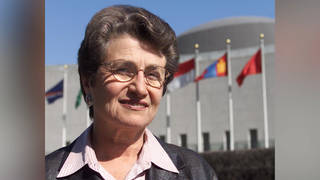
Topics
Guests
- Silja TalviJournalist and Senior Editor at In These Times magazine. Author of the book Women Behind Bars: The Crisis of Women in the U.S. Prison System. Her latest article, “Meet Gus Puryear: Bush’s Latest Villainous Nominee for a Lifetime Judgeship,” is online at Alternet.org.
In 2004, Estelle Richardson’s lifeless and battered body was found on the floor of a Corrections Corp. of America prison cell. Four years later, that unsolved homicide has come back to haunt Republican stalwart “Gus” Puryear, the nation’s top private prison litigator and Bush nominee for US District Court. We talk to journalist Silja Talvi. [includes rush transcript]
Transcript
AMY GOODMAN:
We turn now to an unfolding controversy over a Bush administration nominee for the federal bench. Just under a year ago, President Bush nominated Gus Puryear to serve on the US District Court in Tennessee’s Middle District. Puryear is a Nashville attorney and general counsel for the Corrections Corporation of America, the largest private prison company in the United States. If he’s approved, Puryear would be presiding over the same district where the CCA’s headquarters are based.
Puryear is now coming under new scrutiny for his role in the CCA’s handling of a prisoner death at its Nashville jail. The victim, thirty-four-year-old Estelle Richardson, was found dead with a cracked skull, four broken ribs in her solitary confinement cell. Four guards were implicated in what was later ruled a homicide.
The CCA eventually settled out of court with Richardson’s family. No charges were filed against the guards. But a major new investigative piece on the website Alternet.org says Richardson’s death could come back to haunt Puryear’s nomination for the federal bench.
Silja Talvi is a senior editor at In These Times and author of the book Women Behind Bars: The Crisis of Women in the US Prison System. Her latest article, “Meet Gus Puryear,” is online in two parts at Alternet.org. Silja joins us from Seattle, Washington.
Welcome to Democracy Now!, Sija Talvi.
SILJA TALVI:
Hello. How are you? Good morning.
AMY GOODMAN:
Very good. Tell us about Gus Puryear.
SILJA TALVI:
Let me start out actually by saying that, first of all, it’s an honor to be on the show.
Gus Puryear’s story wouldn’t have been of particular interest for me or to me, had it not been for the fact that I had been following Estelle Richardson’s case for years. I first came across a brief blurb about her murder back in — well, it was four years ago — and wanted to do something to include her story in my book. I had a gut instinct that something terrible had happened to this woman. I tried to track her story over the years and could get very little by way of any information. And very suddenly, in an unusual way, some of this information started to fall into place, and it happened to revolve around this man, Gus Puryear, and his bid for this federal judgeship.
So, he is, as you rightly point out, up for a lifetime appointment. He was nominated last year. And if appointed, that would indeed be for life. And one of the things that people have been bringing up, and rightly so, is that as a thirty-nine-year-old, he’s only brought one federal case to trial so far. So with a real paltry legal background, there’s already the question of, why is he even nominated in the first place? And once some of this stuff started to come up around what he had actually done or has done as general counsel for CCA, that’s really gotten a lot of organizations involved in opposing his nomination.
AMY GOODMAN:
So tell us, in this case of Estelle Richardson, first focusing specifically, then we’ll go larger with Corrections Corporation of America, explain what happened to her and explain what Gus Puryear had to do with it.
SILJA TALVI:
Sure. She was — in the process of trying to find herself in a better place in her life, she headed from Michigan to Tennessee in 1999, and she was actually going down there initially to be a surgical assistant. She was looking for a better life for herself and for her two children. As single mom, she had really been trapped in a very, very low-income, dead-end job as a telemarketer. And so, she headed down there.
Unfortunately, she found that the job opportunities weren’t what she had expected. The school opportunities weren’t what she expected. And she started hustling, like a lot of women do on low end, basically selling prescription pills. Initially she was just acquiring those prescription pills, then she got hooked on them. And she was first picked up around 2001, 2002, and was given a suspended sentence. Unfortunately, her UA subsequently came up dirty. And then she actually was found guilty of food stamp fraud.
And so, she entered the penal system in 2004 in April. By July, July 5th, she was found dead in her cell, unresponsive at 5:37 in the morning. And what we found out subsequently was that she had actually been in solitary confinement for three weeks prior to what then turned out to be a murder, begging the question of who exactly had committed the murder and what exactly had happened to her in that process.
AMY GOODMAN:
And so, what happened with the case? Were guards charged?
SILJA TALVI:
Guards were actually charged. They were charged, however, a year and three months after the situation happened, so after her death had already been ruled a murder. And there were actually five guards involved that we know of — one woman and four men — who had been involved in and had been recorded by fellow inmates in that kind of solitary cell area. Mind you, this is a twenty-three-hour lockdown area. No one comes and goes freely. And we know that there were four men and one woman who had apparently over the course of three weeks beaten this woman to the point where she was bleeding from her ear on a regular basis and trying to use tampons and pads to stuff her ear to keep the bleeding from bleeding all over her sheets and her towels and the floor, which happened anyway. So what we know is that the guards were eventually charged and that those charges were then dropped once the Richardson family had settled with CCA for what was then an undisclosed amount of money.
AMY GOODMAN:
And Gus Puryear’s role in the settlement?
SILJA TALVI:
He was actually very involved to the very last minute. What he did was to hire a bevy of law firms. This is what CCA does; they work with outside law firms. And they got to work on this family and making sure that they were going to sit down at the table for a settlement. She had two minor children, so they were ostensibly the primary concern. But as he himself brags in the testimony to the Senate Judiciary Committee, he was proud to be able to say that on February 22nd, 2006, he sat with the family, sat with everyone until everyone had reached an agreement, and everyone basically went home happy. And that’s his version of the event.
Now, in truth, none of this would have even been of any significance. No one would have paid attention, CCA always involved in these kinds of situations. Scandals, riots, you name it, suicides, murders, CCA has it going on. The thing that makes this different is that Gus Puryear actually went before the Senate Judiciary Committee and initially kind of just waived off these concerns or these questions around Estelle Richardson’s death. And I think he was surprised, but basically he came across as saying, “You know what? First of all, it’s not really a big deal, in essence” — and I’m paraphrasing — but he said, “You know, she could have died any number of ways, and I don’t believe necessarily that her death was a murder at all. In fact she could have fallen and cracked her head on the floor or on the wall,” when in fact the top medical examiner for the State of Tennessee had examined her body right afterward and said that she had basically died of massive sustained blunt force trauma — so her head, her ribs, her organs — that this was the kind of injury that you would see, for instance, in a car crash, a deceleration injury is what it’s called.
And so, when Puryear tried to spin this and say, “You know what? She could have fallen against a wall or hit a floor with her head, having a seizure,” and to their credit, the Senate Judiciary Committee members started saying, “Wait a second, wait a second. This doesn’t sound right.” And they followed up with questions that then he had to in turn respond to, and he did so, but rather poorly. And so there are still these remaining questions around why precisely he continues to dance around the fact that her death was indeed ruled a murder.
AMY GOODMAN:
Silja Talvi, let’s go further into the background of Gus Puryear, President Bush’s nominee, judicial nominee. Tell us about his rise.
SILJA TALVI:
He’s a rather young man. He’s about my age, thirty-nine years old. And he started out with money. He’s basically blue blood, went to an exclusive Christian high school. He went on to Emory, and then from there he got his law degree. And he went — and he — actually only three years that he served as a practicing attorney with a law firm where he was more or less, as they say, an assistant. He also clerked under a Judge Barksdale, who was also an appointee, a Bush Sr. appointee. He’s only — in that time, he only handled, by himself, five trial — five federal cases, and one of those went to trial, and that ironically was that of a prisoner. And as he says very dryly in one of his interviews, “We lost.” And so, that was really his first and only exposure to that side of dealing with prisoner litigation.
Once he actually got recruited — I should backtrack and say he also worked for Senator Frist, and he was involved or friends with a “good guy” named Philip Perry, who turns out to be Dick Cheney’s son-in-law. And so, Philip Perry, who’s very much a Beltway insider, set him up to basically do the debate prep for the 2000 and the 2004 vice-presidential debates. So he’s very much the GOP stalwart and always has been, and his donation dollars reflect that. He’s given about $13,000 in donations to the GOP since 2001. In 2003 — this is just to show you what kind of a symbolic guy he is — he gave $2,000 to the Bush reelection campaign, that was on September 11, 2003.
AMY GOODMAN:
You talk about the support, but also the criticism, when he went before the Senate Judiciary Committee. Can you talk about who came out for and against him?
SILJA TALVI:
Well, at that point, actually, it wasn’t a question of for and against. At that point, there really were no fors. It was a given that this man was going to just be waved into that position. Nobody was even blinking an eye. It was an obvious. Well, here’s this great — you know, he’s a golden boy of the GOP. He’s just going to be waved right on in.
Unbeknownst to him, the Senate Judiciary Committee had received a list of questions and some information from a guy named Alex Friedman, who was a former CCA prisoner who’s also an associate editor at Prison Legal News and has worked with a number of private corrections organizations. And he forwarded that information to the committee, and the committee actually paid attention and said, “Well, who is this Estelle Richardson? Tell us about her. Tell us about her case.” And I was very pleased to see that this kind of thing actually does work this way. They started asking these questions. He was obviously taken by surprise. And that was when he first uttered his statement around, “Well, you know, she could have — she could have fallen. She could have cracked her head this way.”
AMY GOODMAN:
But you have people like Thurgood Marshall, Jr. and the primary attorney who sued CCA on behalf of Richardson’s two children supporting him in the end, once he came under this criticism.
SILJA TALVI:
That comes much — exactly. That comes much late — well, it actually happens — you’re right — pretty rapid-fire after that point. There’s this sort of scramble around, “Oh, my god, what do we do to make sure that he’s backed up?” And so, all of a sudden these letters start showing up, and one of the first is indeed Thurgood Marshall, Jr. And initially I’m thinking, “What? You know, what on earth?” And they’re also using him to deflect the criticism around this Belle Meade Country Club that Puryear belongs to, which only admitted its first African American member in 1994, and to this day only has one member who’s black, who’s in another state, so who doesn’t actually ever show up in the country club.
AMY GOODMAN:
Silja Talvi, we only have twenty seconds. But putting his career at CCA, the largest private prison company in this country, into a larger context.
SILJA TALVI:
CCA is now — represents the fifth largest prison system in the United States. Puryear sits atop that system. Were he to be given this position, he would sit atop a district court that basically governs that entire area, including CCA’s national headquarters. He would ultimately be responsible for deciding the fates of hundreds upon hundreds of prisoners.
AMY GOODMAN:
Silja Talvi, I want to thank you for being with us, journalist and senior editor at In These Times. Her piece appears at Alternet.org.












Media Options